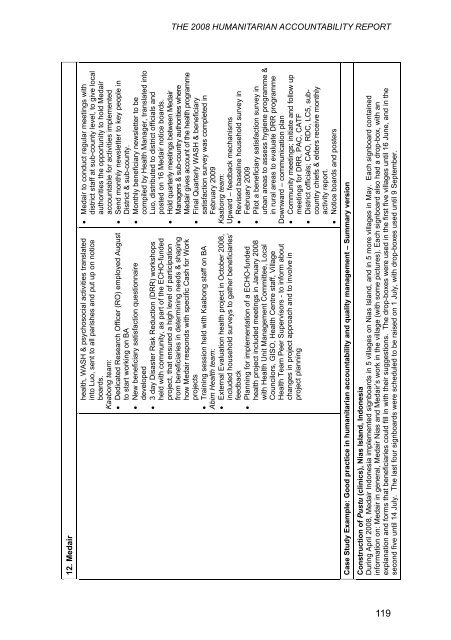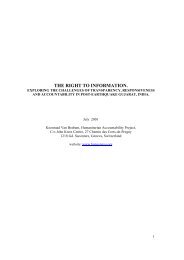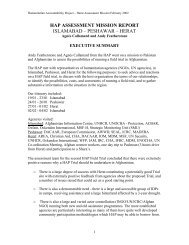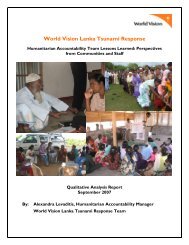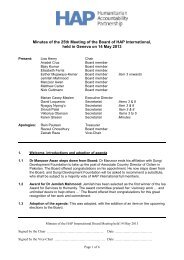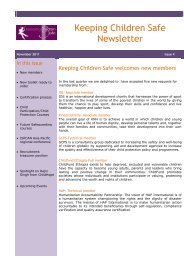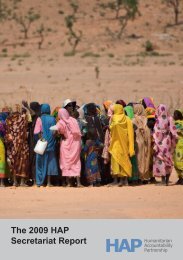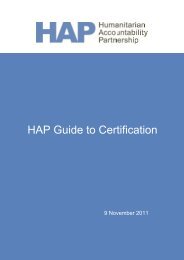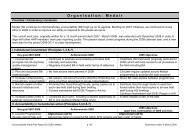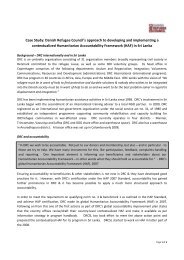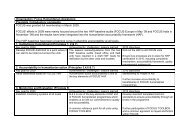Chapter Four - HAP International
Chapter Four - HAP International
Chapter Four - HAP International
Create successful ePaper yourself
Turn your PDF publications into a flip-book with our unique Google optimized e-Paper software.
THE 2008 HUMANITARIAN ACCOUNTABILITY REPORT<br />
12. Medair<br />
health, WASH & psychosocial activities translated<br />
into Luo, sent to all parishes and put up on notice<br />
boards.<br />
Kaabong team:<br />
• Dedicated Research Officer (RO) employed August<br />
to start working on BA<br />
• New beneficiary satisfaction questionnaire<br />
developed<br />
• 3 day Disaster Risk Reduction (DRR) workshops<br />
held with community, as part of the ECHO-funded<br />
project, that ensured a high level of participation<br />
from beneficiaries in determining needs & shaping<br />
how Medair responds with specific Cash for Work<br />
projects<br />
• Training session held with Kaabong staff on BA<br />
Abim Health team:<br />
• External Evaluation health project in October 2008,<br />
included household surveys to gather beneficiaries’<br />
feedback<br />
• Planning for implementation of a ECHO-funded<br />
health project included meetings in January 2008<br />
with Health Unit Management Committee, Local<br />
Councilors, GISO, Health Centre staff, Village<br />
Health Team Peer Supervisors - to inform about<br />
changes in project approach and to involve in<br />
project planning<br />
• Medair to conduct regular meetings with<br />
district staff at sub-county level, to give local<br />
authorities the opportunity to hold Medair<br />
accountable for activities implemented<br />
• Send monthly newsletter to key people in<br />
District & sub-county.<br />
• Monthly beneficiary newsletter to be<br />
compiled by Health Manager, translated into<br />
Luo, distributed to district officials and<br />
posted on 16 Medair notice boards.<br />
• Hold quarterly meetings between Medair<br />
Managers & sub-country authorities where<br />
Medair gives account of the health programme<br />
• Final Quarterly WASH & beneficiary<br />
satisfaction survey was completed in<br />
February 2009<br />
Kaabong team:<br />
Upward – feedback mechanisms<br />
• Revised baseline household survey in<br />
February 2009<br />
• Pilot a beneficiary satisfaction survey in<br />
urban areas to assess hygiene programme &<br />
in rural areas to evaluate DRR programme<br />
Downward – communication plan<br />
• Community meetings; initiate and follow up<br />
meetings for DRR, PAC, CATF<br />
• District officials; CAO, RDC, LC5, subcountry<br />
chiefs & elders receive monthly<br />
activity report.<br />
• Notice boards and posters<br />
Case Study Example: Good practice in humanitarian accountability and quality management – Summary version<br />
Construction of Pustu (clinics), Nias Island, Indonesia<br />
During April 2008, Medair Indonesia implemented signboards in 5 villages on Nias Island, and in 5 more villages in May. Each signboard contained<br />
information on: Medair in general, Medair Nias and Medair’s work in the village (with some pictures). Each signboard also had a drop-box, with an<br />
explanation and forms that beneficiaries could fill in with their suggestions. The drop-boxes were used in the first five villages until 16 June, and in the<br />
second five until 14 July. The last four signboards were scheduled to be raised on 1 July, with drop-boxes used until 9 September.<br />
94<br />
119


